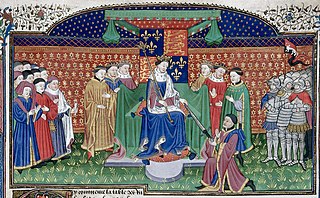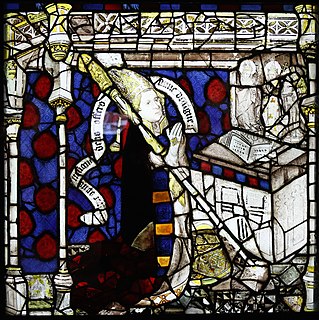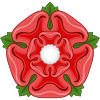Related Research Articles
Simon de Langham was an English clergyman who was Archbishop of Canterbury and a cardinal.

Robert Hallam was an English churchman, Bishop of Salisbury and English representative at the Council of Constance. He was Chancellor of the University of Oxford from 1403 to 1405.

Thomas Rotherham, also known as Thomas (Scot) de Rotherham, was an English cleric and statesman. He served as bishop of several dioceses, most notably as Archbishop of York and, on two occasions as Lord Chancellor. He is considered a venerable figure in Rotherham, South Yorkshire, his town of birth.

Walter de Gray or Walter de Grey was an English prelate and statesman who was Archbishop of York from 1215 to 1255. He was Lord Chancellor under King John.

John Stafford was a medieval English prelate and statesman who served as Lord Chancellor (1432–1450) and as Archbishop of Canterbury (1443–1452).
Walter Giffard was Lord Chancellor of England and Archbishop of York.
Sigeric was the Archbishop of Canterbury from 990 to 994.
John of Thoresby was an English clergyman and politician, who was Bishop of St David's, then Bishop of Worcester and finally Archbishop of York. He was Lord Chancellor of England under King Edward III starting from 1349.
William Booth or Bothe was Bishop of Coventry and Lichfield from 1447 before becoming Archbishop of York in 1452 until his death in 1464.
Dr Thomas Savage was a prelate and diplomat during the Tudor period.

The Archbishop of York is a senior bishop in the Church of England, second only to the archbishop of Canterbury. The archbishop is the diocesan bishop of the Diocese of York and the metropolitan bishop of the Province of York, which covers the northern regions of England as well as the Isle of Man. The archbishop of York is an ex officio member of the House of Lords and is styled Primate of England; the archbishop of Canterbury is the "Primate of All England".
Thomas Brunce was a 15th-century Bishop of Rochester and then Bishop of Norwich.

Walter Skirlaw was an English bishop and diplomat. He was Bishop of Durham from 1388 to 1406. He was an important adviser to Richard II of England and Henry IV of England.
Thomas Cobham was an English churchman, who was Archbishop-elect of Canterbury in 1313 and later Bishop of Worcester from 1317 to 1327.
Philip Morgan was a Welsh clergyman who served as Bishop of Worcester (1419–1426), then as Bishop of Ely (1426–1435).
Godfrey was a medieval Bishop of Bath.
Walter Durdent was Bishop of Coventry from 1149 to 1159.
Louis of Luxembourg;. Bishop of Therouanne 1415-1436, Archbishop of Rouen, 1436, Bishop of Ely 1437, Cardinal.

Samson was a medieval English clergyman who was Bishop of Worcester from 1096 to 1112.
Ealdred was a medieval Bishop of Cornwall. He was consecrated between 981 and a period between 988 and 990. He died between 1002 and 1009.
References
- Allmand, Christopher Henry V Berkeley: University of California Press 1992 ISBN 0-520-08293-1
- Chaplais, Pierre, English Diplomatic Practice in the Middle Ages London: Hambledon and London 2003 ISBN 1-85285-395-6
- Fryde, E. B.; Greenway, D. E.; Porter, S.; Roy, I. (1996). Handbook of British Chronology (Third revised ed.). Cambridge: Cambridge University Press. ISBN 0-521-56350-X.
| Political offices | ||
|---|---|---|
| Preceded by Laurence Allerthorp | Lord High Treasurer 1402 | Succeeded by Guy Mone |
| Catholic Church titles | ||
| Preceded by John Colton | Dean of St Patrick's Cathedral, Dublin 1382–1391 | Succeeded by Thomas de Everdon |
| Preceded by Richard Clifford | Bishop of Bath and Wells 1401–1407 | Succeeded by Nicholas Bubwith |
| Preceded by Robert Hallam | Archbishop of York 1407–1423 | Succeeded by Philip Morgan |
